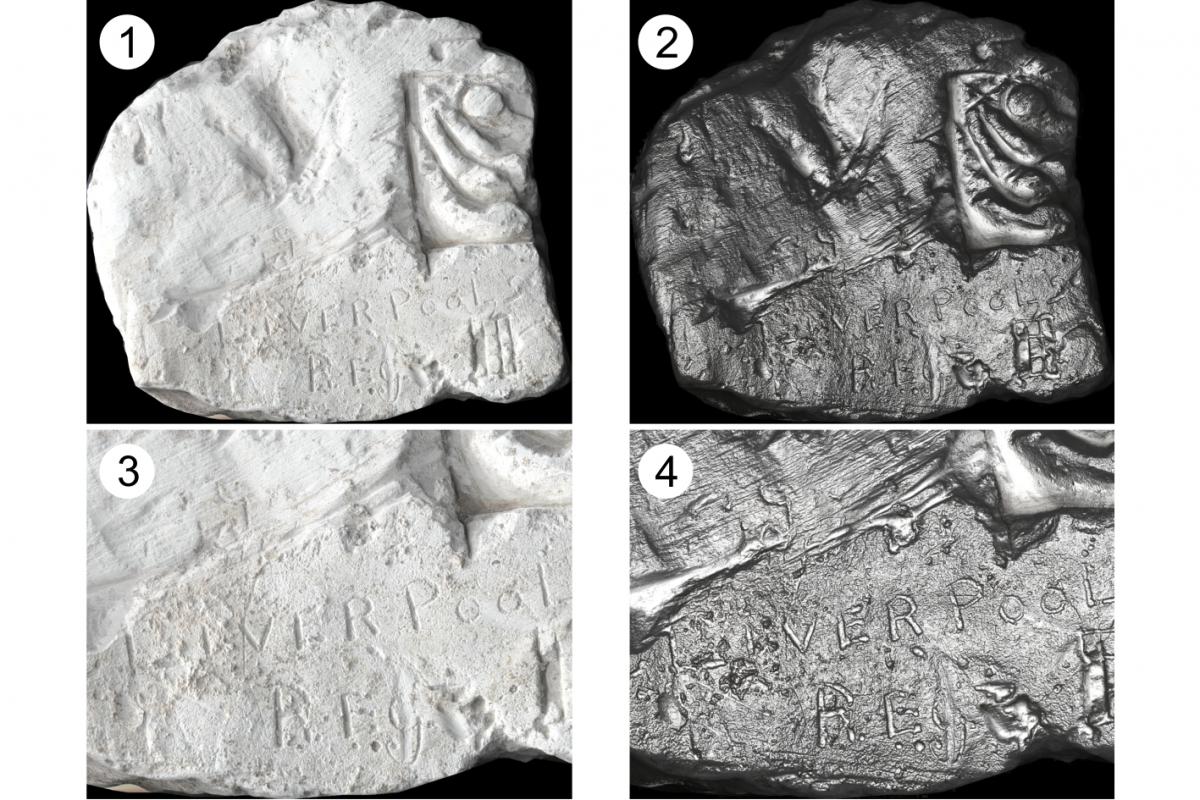This chalk block or plaque was recovered from a section of WW1 front line practice trench at Perham Down on Salisbury Plain during an excavation commissioned by Defence Infrastructure Organisation. The object was cleaned and processed as normal and it became apparent that it was clearly carved with the words ‘Liverpool Reg’ and a difficult to interpret design to one side. Part of the carved face of the plaque was abraded. The fragmentary nature of the block meant that the design was incomplete and required further research. It was common for Regiments to pass through the training areas, particularly the practice trenches and leave their mark, either individually or by regiment.
Initial research suggested that the plaque was carved by a battalion of the Liverpool Pals. In order to assist in confirming this information it was decided to see if RTI would reveal any further hidden surface detail which may aid in correct identification.
The first image (image 1) is viewed with the default setting. Here can clearly be seen ‘Liverpool Reg’ inscription along the bottom and the unusual carving, in a part square border, to the top right. When viewed in specular enhancement (image 2), the significant reflective qualities of chalk become apparent and highlight well the surface detail. What appear to be a set of diagonal cuts in the surface of the chalk at top centre, and at first thought to be damage, can also be seen to be deliberately incised into the chalk. When viewed in close-up and in default setting (image 3), a study of the style of the visible lettering ‘Liverpool reg’ revealed a ‘copper plate’ style specifically to the letter ‘g’ in ‘reg’. When the damaged area above ‘Liverpool’ was studied in close-up and in specular enhancement (image 4), the remains of a letter ‘g’, in a similar style to that in ‘reg’ can be seen. Other letters had been abraded away leaving only the letter ‘g’. Subsequent research into the regiments of Liverpool during the First World War identified The Kings Liverpool Regiment as likely candidates for the carving.

The Kings Liverpool Regiment was set up by Edward George Villiers Stanley the 17th Earl of Derby in response to Lord Kitchener’s appeal for 100,000 volunteers in August 1914. Within five days, the total of volunteers had reached 3000 and by October, there was enough from the city to form four Pals Battalions in the Kings Liverpool Regiment. Lord Derby was so highly thought of that King George V gave permission for the Pals to wear the Derby crest as their insignia. Lord Derby produced silver cap badges for each of the men. The crest depicts an eagle carrying or guarding a child in a small boat above a crown.
When viewed again under specular enhancement, image 2 reveals parts of Lord Derby’s crest. To the right of the image, and within the square border is the baby’s head lying in a crudely depicted boat. Directly above the baby’s head and just outside the top border is the end of a single talon of the eagle. To the top left of the image the curving angled beak of the eagle can be discerned.
In this instance, RTI was used successfully to analysis a delicate surface remotely causing no surface damage and also producing clearer evidence for the origins of the carving.

